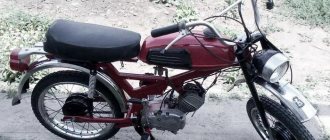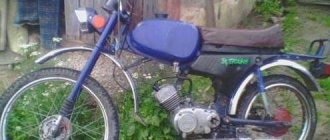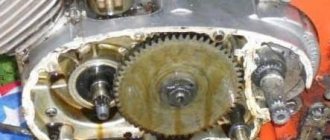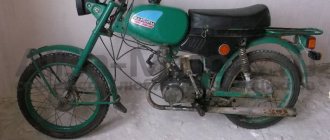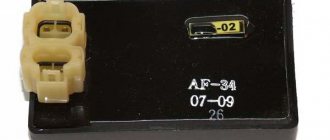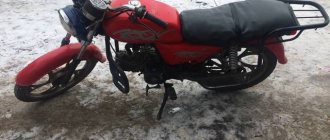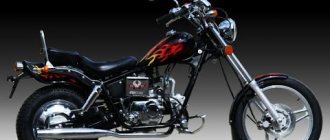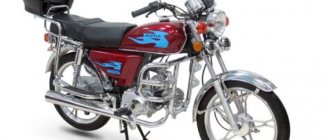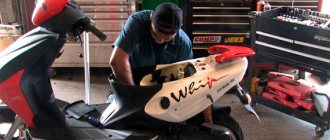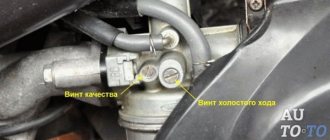I once had such a device. And if you don’t even want to remember all the other outliers of the Soviet motorcycle industry. I have only warm memories about this moped. Yes, he had a lot of shortcomings, but at that time, owning a “Karpacz” as we called him back then was very, very cool.
They asked me to put the allegedly still quite “good” (as the owner said: it has a spark and you just need to tune it and check the first gear as it was knocking out. Well, we’ll see...) moped. As often happens in practice, a supposedly “good” one turns out to be complete rubbish. My further intervention in the technical part of this issue only confirmed this truth.
A quick inspection revealed extensive areas of corrosion, crooked wheels, a frame torn in three places, broken sprockets and chain, missing many bolts and much more.
I remembered my youth, brought a table with tools to the moped and set to work with the same enthusiasm. And there was a lot to do here...
Apparently the roof was leaking in the barn. How else can we explain the presence of water in the generator cover? To my surprise, given the condition of the generator, there was a spark, and a good one.
Clutch
The weakest component in the engine of this moped is the clutch. And it fails first. Oh, and we suffered with this clutch, not only on “Karpaty”, but also on “Riga” and “Verkhovyna”.
In this clutch, the release lever was screwed in first. In those days we called it “bronze finger”. At that time, this device was in terrible short supply and it was simply impossible to find it.
In the one I tested, the release valve was in working order. As they say, he still has to walk and walk.
For those who don’t know, the release lever is located here. Pay attention to how much chips and dirt there are in this engine.
The second weak point of the clutch is its pressure plate, in which it constantly breaks the locking grooves, causing it to fly off the basket.
Removing the pressure disk is very simple: insert a screwdriver into a special hole, hit it a couple of times with a hammer and the disk comes off.
In this example, the grooves through which the disc engages with the basket are still good. Sometimes they are so broken that the disk simply no longer holds on. In such cases, the disk had to be replaced.
The clutch basket spring does not cause any trouble.
The nut that secures the inner drum of the basket was no longer original. There was no thread on it, just like on the crankshaft journal, and it was simply flattened and hammered onto the shaft. It is worth saying that the thread and this entire assembly as a whole are very flimsy. And because of this, the threads constantly screw up and break the splines. And on all engines of this series without exception.
If your nut turns out to be well tightened (which happens very, very rarely), fix the piston through the outlet window with a screwdriver and unscrew it.
The collective farm grower who slapped the nut under the nut did not solve the situation with its spontaneous unscrewing. This is not surprising - the problem is not in the nut, but in the level of technical literacy of the creators of this engine.
The inner drum splines are badly worn. Rapid wear of the splines of this pair is a typical problem with engines of this series.
On all clutch pressure plates without exception, the fingers with which they engage with each other dangle. I put them on the anvil, riveted them on the reverse side and forgot about this problem for a while.
Clutch discs, unlike other clutch parts, do not cause unnecessary trouble.
Often and thickly, the gear breaks off on the outer drum of the clutch basket. I corrected this situation something like this: I put the torn gear back into the basket, pressed it against the basket with a clamp, poured water into the jar, laid the basket on the jar so that the gear was completely hidden in the water and welded it to the body. Then I polished the welds and got a fully functional basket.
The basket on this example is perfect.
The spacer bushing for the outer drum was no longer original and most likely homemade.
We fix the gearbox input shaft gear from turning, unbend the lock washer and unscrew the nut.
The driven gear never breaks and runs for decades. And for some reason the nut that holds it does not unscrew... How can this be done. Two almost identical units are located next to each other, made at the same factory, developed by the same designers. But no. The nut on the basket unscrews, but not on the gearbox input shaft. What is this? Another paradox? A mystery of nature? The machinations of evil spirits? Accident?
Switch-stabilizer block 252.3734
Board drawing .lay
Note! On both printed circuit boards there is no space for the current-limiting resistor R5 (R2). Despite the fact that the circuit will work without this resistor, I still recommend installing it to reduce the load on the charging winding, since it becomes short-circuited when thyristor VS1 is open.
Piston
Unscrew the nuts on the head and remove it from the cylinder. The head and piston for this engine were pristinely clean. Apparently, just before this moped departed for the “other world,” they had already tinkered with it.
The cylinder was removed with great difficulty. Water got into the holes where the pins go and the whole thing became very rusty. A piece fell off from the piston on the exhaust side. This moment is clearly visible in the photo. How did he fly away? Who knows. Maybe they broke it off, or maybe it flew off...
The cylinder mirror was in poor condition. The wear and scratches did their job: compression in the combustion chamber dropped significantly.
The total wear of the piston group was more than 0.09 mm, with a norm of 0.05. For those who don’t know: the wear of the piston group is measured as follows: we wash the piston and cylinder from dirt and old oil residues, insert the piston into the cylinder, orient it in the cylinder as it should stand on the engine, align its skirt with the edge of the cylinder and measure the gap with a feeler gauge between the skirt and the cylinder.
This gap will determine the degree of wear of the piston group. For Soviet garbage dumps, when using very good oil, the norm is 0.03 mm, for bad oil 0.05 mm. Anything more means increased wear.
Collective farm gurus naively believe that the situation with piston wear can be solved by installing new rings. You don’t see these fabrications. And this is not fabrication, but an eternal search for freebies - this is where all sorts of stories about rings and “suprotec” are born.
No rings, even the most “duper” ones, will restore the original geometry of the cylinder and will never fit tightly to a cylinder that has wear in the form of a cone and an ellipse. And for internal combustion engine cylinders, cylinder wear only occurs in the form of a cone along the longitudinal axis and in the form of an ellipse in the transverse axis.
Think for yourself: how can an ideal circle in the form of a new piston ring fit tightly onto an ellipse? She won't lie down.
Remove the bolts on the crankcase.
We take a technical hair dryer, heat the crankcase with it, warm the places under the bearings especially well and hit the shafts with a mallet to “halve” the engine.
The gearbox parts in this particular engine were of disgusting quality. On those still old mopeds, the parts were much better quality than on this example. It’s not surprising - this moped was produced in 1994, and in those years the quality of the products dropped many times over.
The cam clutches on the gearbox parts of this engine are somehow strange. Either they came like this from the factory, or someone had already managed to take them away from the collective farm. Unclear. Only one thing is clear: the quality is complete guano, even in the photo you can see how the coupling cams were simply cut either with a “grinder” or on a machine - I still don’t understand.
The carriage that includes the gears had severe wear on the edges of the jaw couplings. Hence the problems with the transmission jumping out.
Carpathians
The model turned out to be not very successful. After practice at the Czech motorcycle plant JAWA in the sixties, serial production of the first mopeds in the USSR began - Riga-1. Riga mopeds were constantly modernized. In the film Adventures of Electronics, Syroezhkin rode on a RIGA moped. The Sarkana zweigzne plant was actively operating until the early 90s. The perestroika crisis became fatal for the illustrious enterprise; soon Riga mopeds from the USSR ceased to be produced, and the plant ceased to exist. In addition to the Riga brand models, the Verkhovina and Delta models were the most popular in the USSR. The USSR Delta moped is a real star of the eighties. The Delta moped was equipped with two types of engines: V-50 - manual gear shift, V-50M (V-501M) - foot. Engine capacity - 40-50 cm3.
Speed - 50 km/h. The Delta moped was especially loved in the USSR because it resembled the Czech Java motorcycle (JAWA). In the eighties, every boy dreamed of having his own moped. Happy owners of mopeds united in groups and drove in packs along city streets and country roads. Those who did not have their own Delta or Verkhovyna helped moped owners in repairing and improving the model. The peak of popularity for mopeds in the USSR occurred in 1985. The beginning of the dashing nineties put an end to the mass passion for mopeds. Soviet retro mopeds are still of interest to motorcycle enthusiasts. A large number of different photos of USSR mopeds are posted on websites on the Internet. From two or three old Delta mopeds, one full-fledged working retro moped is assembled. Some Soviet mopeds from the eighties are still running without significant repairs.
Nowadays, Chinese-made mopeds are produced under the name Delta, but they cannot be compared with the Soviet retro Delta mopeds, which were once created specifically for Russian roads. Hello, dear Bike Posters! Please help me determine the malfunction of the V-501M engine of the Verkhovina-6 moped from the video below, the wording of the question. I don't have enough experience and knowledge in this matter. I have been the happy owner of the Soviet moped LMZ-2 for 8 years now. 158 Verkhovyna-6 1977 with engine V-501M 2001. (foot gear shift). Despite all its charm, it, like most Soviet technology, is unfortunately not reliable enough. Therefore, during its operation I have already climbed it up and down.
And he successfully satisfied all his whims and caprices. I actively used the moped at the dacha for about 5 seasons. This season I moved him to Moscow in order to resume riding. But this season, having spent a total of about a month on repairs, I was still unable to rev it up properly due to constant problems with the engine. The total mileage for this season is about 150 km on several sets of piston rings, etc. (small, but very fun mileage =)). I recently removed the engine from the frame to determine the cause of its instability. After examining it, I recorded my observations, which I described below in the problem. Question/Task There is a moped LMZ-2. 158 Verkhovyna-6 1977 Engine V-501M 2001. Crank mechanism. Problem: Piston rings keep breaking. And they don’t go 100 km.
The final touch remains - painting the Carpathians
I painted it with Mobihel enamel - color No. 813594 "Ruby Red" - it seemed to me the most suitable for this moped. The surface dried for three days.
I bought the Carpathians for 1000 rubles in “trash” condition. Restored for 7 months. I sold it later for 5,200 rubles.
In general, it seems that he completed the task - he managed to sell it for 5 times more than he purchased it.
But the catch is that I spent about 6,400 rubles on parts and consumables (and I didn’t spend money on the motor, since I had one, otherwise I would have had to add 3,500-4,000 rubles on top).
As a result, I ended up in the red. But since the whole idea was not for making a profit, but to get my hands on restoring mopeds, I’m generally satisfied.
Now I bought myself a used Kawasaki and am restoring it.
It’s worth sharing the result later - write in the comments if you would be interested in my story about this?
And by the way, has anyone else been involved in restoring mopeds? How much did it cost you? Write in the comments and subscribe!
In the post-Soviet space, the Karpaty moped is one of the most popular small vehicles on two wheels. Compared to similar units, the device in question was distinguished by good quality, practicality and original design. Among the features, it is necessary to note the three-block type clutch. The two-speed gearbox provided a fairly good smooth start and maximum speed (45-50 km/h).
Photo report: How to disassemble the engine of the Karpaty moped
I once had such a device. And if you don’t even want to remember all the other outliers of the Soviet motorcycle industry. I have only warm memories about this moped. Yes, he had a lot of shortcomings, but at that time, owning a “Karpacz” as we called him back then was very, very cool.
They asked me to put the allegedly still quite “good” (as the owner said: it has a spark and you just need to tune it and check the first gear as it was knocking out. Well, we’ll see...) moped. As often happens in practice, a supposedly “good” one turns out to be complete rubbish. My further intervention in the technical part of this issue only confirmed this truth.
A quick inspection revealed extensive areas of corrosion, crooked wheels, a frame torn in three places, broken sprockets and chain, missing many bolts and much more.
I remembered my youth, brought a table with tools to the moped and set to work with the same enthusiasm. And there was a lot to do here...
Apparently the roof was leaking in the barn. How else can we explain the presence of water in the generator cover? To my surprise, given the condition of the generator, there was a spark, and a good one.
Peculiarities
Despite the fact that it was almost impossible to somehow tune the unit, its ease of maintenance and the ability to independently repair absolutely all units certainly played a key role in its popularity. Original spare parts for the Karpaty moped were made of high-quality metal, although equipment of that time often broke down due to design and technical defects.
The trunk of the vehicle in question could withstand more than one hundredweight of cargo. The tires had a high tread, which made it possible to operate the equipment in winter. Drum brakes were quite enough for the weight and dynamics of the small motorcycle. The power unit itself is a regular two-stroke engine. Almost every owner of this representative of motorcycle equipment can replace the rings or piston.
Original spare parts for “Karpaty”, moped “Verkhovyna”
It is worth noting that original spare parts for “Karpaty” are made from high-strength steel alloys, as well as other reliable materials. The same applies to components for the Verkhovyna moped. Other advantages of the product include:
- compliance with the parameters of factory-installed parts;
- a simple installation principle, which allows you to carry out repairs yourself in many cases, without turning to specialized specialists;
- affordable price
Indeed, motor vehicles from these manufacturers are much cheaper to maintain and maintain compared to mopeds from Japanese brands. In addition, the engines, piston groups and many other components presented in the catalog will help not only repair motorcycle vehicles, but also modernize them.
Competitors
The closest competitor in terms of characteristics was the Verkhovyna vehicle. The Karpaty moped's ignition, clutch assembly, design and some other indicators were significantly superior to its rival. In addition, the Delta, Verkhovyna-7 competed with the vehicle in question. Although all components of these variations were modernized, preference was given to the Carpathians.
There are several reasons for this. Firstly, the price of the Delta was higher, and it was produced in Riga. Secondly, the improved Verkhovyna had a warranty mileage of 6,000 kilometers, and a service life before major repairs of 15 thousand. The Carpathian moped at the same time had eight and eighteen thousand, respectively.
More than one generation, especially in rural areas, has studied every cog in this unit. A brief overview of the location of the main elements:
- The air filter is located directly behind the carburetor.
- The gearshift control lever is on the left, the brakes on the right.
- Also on the steering wheel is the clutch handle, gas, and front brake.
It is worth noting that there is no electric starter, so a fairly popular way to start the engine was to activate it with a push or paw.
Reliable spare parts for the moped “Karpaty”, “Verkhovyna”
In addition to spare parts for the Karpaty moped, we also have components for Verkhovyna. Factory-produced parts have a long service life, no less than that of original spare parts. High-quality components will help to significantly increase the interval between maintenance. The best ratio of price and quality. We are waiting for your orders, please contact us!
The online store has a wide selection of spare parts for “Karpaty”, as well as for the fairly popular “Verkhovyna” mopeds. Motor vehicles of these models are attractive due to their low cost of maintenance, which can be seen in the cost of components and parts.
The store's wide assortment allows you to buy an engine, clutch, and other key elements. The factory-made crankshaft, carburetor, and piston group are distinguished by high quality assembly, which guarantees a long service life.
Nuances of repair work
Almost every owner could repair a Karpaty moped on their own. Quite often it was necessary to rebuild the engine. No matter how difficult this work may seem, thanks to the simple design of the motor of the unit in question, everything could be done quickly and efficiently.
If the cause of the breakdown is the failure of the bearings, crankshaft, rings, the engine will need to be split. This is a relatively simple procedure, much more difficult to put everything back together correctly. Although, if you pay close attention to the process and recommendations in the instructions, everything is very real.
Gaskets for the muffler can be cut out of thick cardboard and lubricated with grease. Important: when tightening the nuts, it is necessary to maintain the optimal force, avoiding insufficient fastening or stripping the threads. The Karpaty moped runs on a mixture of gasoline and oil; there is no special oil receiver. The optimal fuel is AI-80.
Specifications
What technical parameters does the Karpaty moped have? Characteristics of the main components are presented below:
- Full weight – 55 kg.
- Maximum load – 100 kg.
- Base – 1.2 m.
- Length/height/width – 1.8/1.1/0.7 m.
- Clearance – 10 cm.
- The maximum speed limit according to the passport is up to 45 km/h.
- Fuel consumption per hundred is 2.1 liters.
- Frame type – construction based on welding of a tubular sample.
- Front suspension unit - telescopic fork, spring shock absorbers.
- The rear suspension is shock-absorbing springs with a pendulum.
- The total braking distance at 30 km/h is 7.6 m.
- Tire categories - 2.50-16 or 2.75-16 inches.
- The power unit is a V-50 carburetor, two strokes, air cooling.
- Volume - 49.9 cubic meters. cm.
- Cylinder size – 3.8 cm.
- Piston stroke – 4.4 cm.
- Compression ratios range from 7 to 8.5.
- Motor power – 1.5 l. With.
- Maximum torque – 5200 rpm.
- Gearbox – two stages, manual or similar with foot switch.
Other parameters
Other characteristics that the Karpaty moped has are as follows:
- Electrical equipment – contactless electronic ignition system with alternator.
- Transmission - multi-disc clutch.
- Fuel capacity – 7 liters.
- The gear ratio of the motor transmission is 4.75.
- The same ratio from the gearbox to the rear wheel is 2.2.
- Carburetor type – K60V.
- The energy supplier is a 6 V AC generator with a power of 45 W.
- The filter element is air type with a paper filter.
- Gas exhaust - a muffler with partitions for throttling the exhaust.
- Fuel mixture - A-76-80 gasoline with oil (ratio - 100:4).
Generator 26.3701
The generator is designed to work as a source of electrical energy in the electrical equipment system of mopeds with an engine with a working volume of 50 cm3. Works complete with high-voltage transformer 21.3705 and electronic switch-stabilizer unit 251.3734 (252.3734). Operating conditions: ambient temperature from -40 to +90 °C, relative air humidity 95% at 40 °C. The generator is manufactured in the following climatic versions: U, T. The rotor is a permanent magnet cast from a special alloy. It is installed on a conical shaft journal, secured with a key and secured with a bolt. The sensor magnet is located on the front of the rotor. In the stator housing, made of sheets of electrical steel, there are eight coils: two of them generate current for the ignition coil, the remaining six - to power the headlight, brake light, tail light and sound signal. A magnetic shunt made of magnetic steel is installed on the charging coils. Output terminals are mounted on the front cover.
Specifications
Generator. AC, synchronous excitation. from permanent magnets
Stator. tape 08kp-M-NT-2-0-1.5 number of grooves. 8 number of coils and their connection: in the lighting circuit. 6, serial in the ignition charging circuit. 2, serial in the sensor circuit. 1
number of turns in the coil of the lighting circuit. 25 brand and diameter of the wire of the lighting circuit coils. PEV-2; 1.08 mm
number of turns in the charging coil. 1650 brand and diameter of the wire of the charging coils. PEV-2; 0.12 mm
number of turns in the sensor winding. 1000 brand and diameter of the sensor winding wire. PEV-2; 0.15 mm
Resistance, Ohm: lighting circuits. 0.3 charging ignition circuit. 430 sensor circuit. 40
Rotor. with the main permanent magnet UND4 and the ignition system sensor magnet; Filled with aluminum alloy Cover. tape 10kp-M-NT-2-O-1.5
Execution: according to the method of suppressing radio interference. unshielded in terms of protection against penetration of foreign bodies and water. 1ROO (GOST 14254-80)
Mount: sgatora. flanged, with screws in the rotor engine crankcase. bolt on the crankshaft shank cone. Weight, kg. 2
Modifications and years of production
The Karpaty moped first appeared in 1981 at the Lviv Motorcycle Plant. Five years later, a model called Karpaty-2 was released. The second version of the moped was 0.2 liters. With. weaker and one and a half kilograms lighter than its predecessor. Otherwise, both modifications were identical. The closest similar moped in terms of characteristics was the Riga Delta.
Between 1988 and 1989, more than 260 thousand Karpaty mopeds were produced. In the latest versions, the developers have determined the mileage period before warranty repair is 18 thousand kilometers. There were several more modifications, namely:
- Karpaty-Sport (front wheel of larger diameter, foot-operated gear shift, muffler mounted at the top).
- Carpathians-Tourist with windshield.
- Karpaty-Lux with direction indicators.
For the last few years, the units in question have not been produced. There are several similar variations made in China.
moped karpaty engine repair
In Soviet times, mopeds were incredibly stylish and fashionable personal vehicles. Especially among young people. The queue to purchase a car lasted for years, prices were high. The motorcycle was also expensive and still required garage storage. And a moped, like a bicycle, was often brought into the apartment. You didn't need a license to drive a moped. USSR mopeds cost from 100 rubles. The sale of mopeds in the USSR was carried out in motorcycle stores, almost always by appointment. It was necessary to register in line for a moped every morning for a month or six months. Mopeds of the USSR were produced at the Penza Bicycle Plant (ZIF light moped), Lviv Motorcycle Plant (Verkhovyna moped, Karpaty moped), Riga Motorcycle Plant (Riga moped, Delta moped). The first Soviet moped was produced in 1958 at the Riga motorcycle plant Sarkana zvaigzne: Riga-18.
Owner reviews
There are many ardent supporters and opponents of this moped. The former are more likely to include those who like to delve into technology with their own hands and achieve certain results. If you analyze the majority of reviews, you can find out what users like and why they are persistently negative.
The Karpaty moped has the following advantages:
- Economical.
- Practicality.
- Easy to repair.
- Good handling.
- Decent design.
Users identified the following aspects as disadvantages:
- Low speed.
- Lack of original spare parts on the modern market.
- Rapid overheating in hot weather.
- Not very high quality shock absorbers and weak side shields.
It is worth noting that some lovers of two-wheeled vehicles collect entire collections of Soviet-made mopeds and restore them. The cost of the vehicle in question depends on its condition and modification. The Karpaty moped, the price of which varies from 100 to 500 dollars, can be purchased exclusively on the secondary market. It’s easy to find a suitable model on online resources involved in buying and selling.
